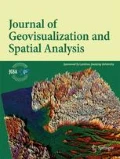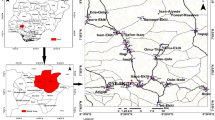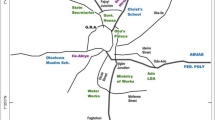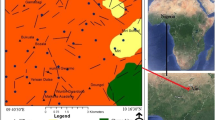Abstract
The area of Akoko with a progressively increasing population and infrastructural development, underlain by rocks typified of a basement terrain, was subjected to the search for potential groundwater recharge sites, to meet the challenge of water demand in the future. Groundwater recharge indicators such as lithology, topography, geomorphology, lineament density, soil, rainfall, drainage density, and land use/land cover were employed for this study. Reclassified raster layers of these recharge indicators were generated from the acquired datasets. These indicators were then delineated, weighted, and classified on the basis of understanding of the local geology and hydrogeology of the study area using Saaty’s approach (Saaty Eur J Oper Res 48:9–26, 1990). These indicators were integrated into a GIS environment to produce a potential groundwater recharge map for the Akoko area. Five classes of potential groundwater recharge (poor, fair, moderate, good, and very good, with the following area coverage of 446.42 km2 (26%), 772.65 km2 (45%), 291.89 km2 (17%), 154.53 km2 (9%), and 51.51 km2 (3%), respectively, were delineated. The generated groundwater recharge map was validated with available borehole records that established a relationship between the groundwater recharge mapped areas and basement aquifers. The mapping of these recharge areas aided better understanding of the groundwater dynamics and proper water resource management for anticipated purposes in the Akoko area, and can be applied to any several basement terrains.











Similar content being viewed by others
References
Abiola O, Ogunribido THT, Omoniyi BA, Ikuepamitan O (2013) Geoelectric assessment of groundwater prospects in Supare Estate, Supare Akoko, Southwestern Nigeria. Gesociences 3(1):23–33
Acworth RI (1987) The development of crystalline basement aquifers in a tropical environment. Q J Eng Geol 20:265–272
Adegbuyi O, Ogunyele AC, Odindu M, Erinfolami TG (2017) Geochemical characteristics and petrogenesis of basement rocks in Idoani area, Ondo State, Southwestern Nigeria. Int J Adv Geosci 5(2):102–108
Adekoya JA, Kehinde-Phillips OO, Odukoya AM (2003) Geological distribution of mineral resources in southwest Nigeria. In: Elueze AA (ed) Prospects for investment in mineral resources of southwestern Nigeria. Nigerian Mining and Geosciences Society Publications 1–13
Ademeso O, Adeyeye O (2011) The petrography and major element geochemistry of the granite gneiss of Arigidi area, Southwest Nigeria. Nat Sci 9(15):7–12
Adesida A, Anifowose AYB, Ojo JS (2011) A study of basement fracture pattern around Akoko area of Southwestern Nigeria for groundwater potential using high-resolution satellite imagery and electrical resistivity. Glob J Geol Sci 10(1):59–69
Afuye GG, Oloruntade AJ, Mogaji KO (2015) Groundwater quality assessment in Akoko south east area of Ondo State Nigeria. Int J Sci Technol 5(9):1–9
Ajayi AO (2009) Characterization of surface and groundwater with reference to microbiological study in Akungba-Akoko, Ondo State. J Microbiol Antimicrob 2(1):6–12
Ajayi JO (2017) Water from Rocks. An Inaugural Lecture delivered at the Obafemi Awolowo University Press, Ile-Ife on 11th April 2017. Inaugural Lecture Series Press, Ile-Ife 67p
Akintorinwa OJ (2014) Groundwater potential assessment of Iwaro-Oka, SW Nigeria using geoelectric parameters. Br J Appl Sci Technol 6(4):364–377
Aladejana OO (2012) Groundwater potential modelling using remote sensing and GIS: a case study of the Akure area, 94p. Mtech thesis, The Federal University of Technology, Akure (Unpublished)
Aladejana OO, Anifowose AYB, Fagbohun BJ (2016) Testing the ability of an empirical hydrological model to verify a knowledge-based groundwater potential zone mapping methodology. Model Earth Syst Environ 2(174):1–17
Aluko OE, Igwe O (2017) An integrated geomatics approach to groundwater potential delineation in the Akoko-Edo area, Nigeria. Environ Earth Sci 76:240–244
Al-Saud M (2008) Using ASTER images to analyze geologic linear features in Wadi Aurnah Basin, western Saudi Arabia. Open Remote Sens J 1:17–25
Aminu MB, Ajayi OO, Adelabu OG (2014) Analyses of domestic groundwater sources in Okeagbe-Akoko, southwestern Nigeria. IOSR-JAGG 2(2):29–34
Anifowose AYB, Aladejana OO (2016) A preliminary assessment for groundwater in a part of north central Nigeria using Landsat ETM+. Glob J Geol Sci 14:1–12
Chandra S, Ahmed S, Ram A, Dewandel B (2008) Estimation of hard rock aquifers hydraulic conductivity from geoelectric measurements: a theoretical development with field application. J Hydrol 357(3–4):218–227
Chilton RC, Foster SSD (1995) Hydrogeological characterization and water supply potential of basement aquifers in tropical Africa. Hydrogeol J 3(1):36–49
Chilton RC, Smith-Carington AK (1984) Characteristics of the weathered basement aquifer in Malawi in relation to rural water supplies. IAHS Publ 144:57–72
Chowdhury A, Jha MK, Chowdary VM, Mal BC (2009) Integrated remote sensing and GIS-based approach for assessing groundwater potential in West Medinipur district, West Bengal, India. Int J Remote Sens 30(1):231–250
Dada SS (2006) Proterozoic evolution of Nigeria. In: Oshin O (ed) The basement complex of Nigeria and its mineral resources (a tribute to Prof. MAO Rahaman). Akin Jinad and Company, Ibadan, pp 29–44
De Vries JJ, Simmers I (2002) Groundwater recharge: an overview of processes and challenges. Hydrogeol J 10:5–17
Deepika B, Avinash K, Jayappa KS (2013) Integration of hydrological factors and demarcation of groundwater prospect zones: insights from remote sensing and GIS techniques. Environ Earth Sci 70(3):1319–1338
Dewandel B, Lachassagne P, Wyns R, Marechal JC, Krishnamurthy NS (2006) A generalized 3-D geological and hydrogeological conceptual model of granite aquifers controlled by single or multiphase weathering. J Hydrol 30:260–284
Diop S, Tijani MN (2008) Assessing the basement aquifers of eastern Senegal. Hydrogeol J 26:1349–1369
Duze M, Ojo A (1982) Senior school atlas. Macmillian Education, Lagos 113p
Edet AE, Teme SC, Okereke CS, Esu EO (1998) Application of remote sensing data to groundwater exploration: a case study of the Cross River State, southeastern Nigeria. Hydrogeol J 6:394–404
El-Awar FA, Makke MK, Zurayk RA, Mohtar RH (2000) A hydrospatial hierarchical method for siting water harvesting reservoirs in dry. Appl Eng Agric 16(4):395–404
Ettazarizini S, El Mahmouhi N (2004) Vulnerability mapping of the Turonian limestone aquifer in the phosphate plateau (Morocco). Environ Geol 46:113–117
Fagbohun BJ (2018) Integrating GIS and multi influencing factor technique for delineation of potential groundwater recharge zones in parts of Ilesha Schist Belt, Southwestern Nigeria. Environ Earth Sci 77(69). https://doi.org/10.1007/s12665-018-7229-5
Fagbohun BJ, Olabode OF, Adebola AO, Akinluyi FO (2017) GIS-based sub-basin scale identification of dominant runoff processes for soil and water management in Anambra area of Nigeria. Contemp Trends Geosci 6(2):80–93
Falowo OO, Ojo OO, Akindureni Y (2017a) Groundwater potential and vulnerability assessment from integrated geophysical methods, borehole logging and hydrogeological measurement. IJASRE 3(8):41–57
Falowo OO, Akindureni Y, Ojo OO (2017b) Irrigation and drinking water quality index determination for groundwater quality evaluation in Akoko Northwest and Northeast areas of Ondo State, Southwestern Nigeria. Am J Water Sci Eng 3(5):50–60
Fashae OA, Tijani MN, Talabi AO, Adedeji OI (2014) Delineation of groundwater potential zones in the crystalline basement terrain of SW-Nigeria: an integrated GIS and remote sensing approach. Appl Water Sci 4(1):19–38
Fenta AA, Kifle A, Gebreyohannes T, Hailu G (2015) Spatial analysis of groundwater potential using remote sensing and GIS-based multi-criteria evaluation in Raya Valley, northern Ethiopia. Hydrogeol J 23:195–206
Ferre E, Deleris J, Bouchez JL, Lar AU, Peucat JJ (1996) The pan-African reactivation of Eburnean and Archean provinces in Nigeria: structural and isotopic data. J Geol Soc Lond 153:719–728
Fetter CW (1994) Applied hydrogeology, 3rd edn. Prentice Hall, Englewood Cliffs 691p
Food and Agriculture Organization (FAO) (1990) Nigeria: Land resources management study. Annex 6: proposals for improved soil and water management in representative (pilot) areas. Appendix 1: The very humid zone. Food and Agriculture Organization, Rome
Hammouri N, El-Naqa A, Barakat M (2012) An integrated approach to groundwater exploration using remote sensing and geographic information systems. J Water Resour Prot 4:717–724
Idowu OA, Ajayi O (1998) Groundwater occurrence in southwestern Nigeria: a comparison of two geological environments. Water Resour 9:33–40
Jaiswal RK, Mukherjee S, Krishnamurthy J, Saxena R (2003) Role of remote sensing and GIS techniques for generation of groundwater prospect zones towards rural development: an approach. Int J Remote Sens 24(5):993–1008
Jones HA, Hockey RD (1964) The geology of part of South-western Nigeria. Geol Surv Nigeria Bull 31 87p
Kaliraj S, Chandrasekar N, Magesh NS (2014) Identification of potential recharge zones in Vaigai upper watershed, Tamil Nadu, using GIS-based analytical hierarchical process (AHP) technique. Arab J Geosci 7(4):1385–1401
Karanth KR (1987) Groundwater assessment development and management. Tata McGraw Hill Publishing, Noida 720p
Kimrey J (1985) Proposed artificial recharge sites in northern Qatar. United States Department of the Interior Geological Survey. Open file report 85-343
Kosmas C, Danalatos N, Cammeraat LH, Chabart M, Diamantopoulos J, Farand R, Gutierrez L, Jacob A, Marques H, Martinez-Fernandez J, Mizara A, Moustakas N, Nicolau JM, Oliveros C, Pinna G, Puddu R, Puigdefabregas J, Roxo M, Simao A, Stamou G, Tomasi N, Usai D, Vacca A (1997) The effect of land use on runoff and soil erosion rates under Mediterranean conditions. Catena 29:45–59
Krishnamurthy J, Mani A, Jayaraman V, Manivel M (2000) Groundwater resources development in hard rock terrain- an approach using remote sensing and GIS techniques. Int J Appl Earth Obs Geoinf 2(3–4):205–215
Machiwal D, Jha MK, Mahnot SC, Mal BC (2011) Assessment of groundwater potential in a semiarid region of India using remote sensing, GIS and MCDM techniques. Water Resour Manag 25(5):1359–1386
Madan KJ, Chowdary VM, Chowdhury A (2010) Groundwater assessment in Salboni block, West Bengal (India) using remote sensing, geographical information system and multi criteria decision analysis techniques. Hydrogeol J 18(7):1713–1728
Mahmoud SH (2014) Delineation of potential sites for groundwater recharge using a GIS-based decision support system. Environ Earth Sci 72(1):3429–3442
Mogaji KA (2016) Geoelectrical parameter-based multivariate regression borehole yield model for predicting aquifer yield in managing groundwater resource sustainability. J Taibah Univ Sci 10:584–600
Mogaji KA, Aboyeji OS, Omosuyi GO (2011) Mapping of lineaments for groundwater targeting in the basement complex region of Ondo State, Nigeria, using remote sensing and geographic information system (GIS) techniques. Int. J Water Resour Environ Eng 37:150–160
Mogaji KA, Lim HS, Abdullah K (2014) Regional prediction of groundwater potential mapping in a multifaceted geology terrain using GIS-based Dempster-Shafer model. Arab J Geosci 8(5):3235–3258
Nair HC, Padmala D, Joseph A, Vinod PG (2017) Delineation of groundwater potential zones in river basins using geospatial tools- an example from Southern Western Ghats, Kerala India. J Geovis Spat Anal 1:5
National Population Commission (NPC) (2006) Population and housing census: population distribution by sex, state, LGA, and Senatorial District. http://www.population.gov.ng
Nigeria Geological Survey Agency (NGSA) (2006) Published by the Authority of the Federal Republic of Nigeria
Novaline JRM, Sundaram A, Natarajan T (1993) Watershed development using geographic information system techniques. Int J Remote Sens 14:3239–3247
Obaje NG (2009) Geology and mineral resources of Nigeria. Springer Dordrecht, Heidelberg, 221p
Odeyemi IB, Malomo S, Okufarasin YA (1985) Remote sensing of rock fractures and groundwater development success in parts of South Western Nigeria. Natural Resources Forum, United Nations, New York
Offodile ME (2014) Hydrogeology: groundwater study and development in Nigeria 3rd edn Fab Anieh Nig Ltd, Jos, Nigeria 636p
Oh HJ, Kim YS, Choi JK, Park E, Lee S (2011) GIS mapping of regional probabilistic groundwater potential in the area of Pohang City, Korea. J Hydrol 399:158–172
Olorunfemi MO, Olorunniwo MA (1985) Geoelectric parameters and aquifer characteristics of some parts of Southern Nigeria. Geol Appl E Idrogeol 20:99–109
Oluwafemi O, Oladunjoye MA (2013) Integration of surface electrical and electromagnetic prospecting methods for mapping overburden structure in Akungba-Akoko Southwestern Nigeria. Int J Sci Technol 2(1):122–147
Omolabi PO, Fagbohun BJ (2018) Mapping suitable sites for water storage structures in Sokoto-Rima basin, Northwest Nigeria. Remote Sens Appli Soci Environ 13:12–30
Oyedotun TDT, Obatoyinbo O (2012) Hydro-geochemical evaluation of groundwater quality in Akoko North West local government area of Ondo State, Nigeria. Revista Ambiente & Agua 7(1):67–80
Prasad RK, Mondal NC, Banerjee P, Nandakumar MV, Singh VS (2008) Deciphering potential groundwater zone in hard rock through the application of GIS. Environ Geol 55(3):467–475
Rahaman MA (1988) Recent advances in the study of the basement complex of Nigeria Precambrian geology of Nigeria. Geol Surv Nig 3:11–41
Rahaman MA (1989) Review of the basement geology of Southwestern Nigeria. In: Kogbe CA (ed) Geology of Nigeria. Elizabeth Publishing Co., Lagos, pp 41–58
Rahman MA, Rusteberg B, Gogu RC, Lobo Ferreira JP, Sauter M (2012) A new spatial multi-criteria decision support tool for site selection for implementation of managed aquifer recharge. J Environ Manag 99:61–75
Rao YS, Jugran DK (2003) Delineation of groundwater potential zones and zones of groundwater quality suitable for domestic purposes using remote sensing and GIS. Hydrol Sci J 48(5):821–833
Roscoe MO (1990) Handbook of groundwater development. Wiley, New York 512p
Saaty TL (1977) A scaling method for priorities in hierarchical structures. J Math Psychol 15:57–68
Saaty TL (1980) The analytic hierarchy process. McGraw-Hill, New York
Saaty TL (1990) How to make a decision: the analytic hierarchy process. Eur J Oper Res 48:9–26
Saaty TL (1994) Fundamentals of decision-making and priority theory with the analytic hierarchy process. RWS Publications, Pittsburgh
Sani Y, Noordin A, Rany FA (2010) Multi-criteria analysis for flood vulnerable areas in Hadejia-Jama’are river basin, Nigeria. Eur J Sci Res 42(1):71–83
Saraf AK, Choudhury PR (1998) Integrated remote sensing and GIS for groundwater exploration and identification of artificial recharge sites. Int J Remote Sens 19:1825–1841
Semere S (2003) Remote sensing and GIS: applications for groundwater potential assessment in Eritrea. Environmental and natural resources information systems. Royal Institute of Technology, Stockholm 147p
Senanayake IP, Dissanayake DMDOK, Mayadunna BB, Weerasekera WL (2016) An approach to delineate groundwater recharge potential sites in Ambalantota, Sri Lanka using GIS techniques. Geosci Front 7:115–124
Sener E, Davraz A, Ozcelik M (2005) An integration of GIS and remote sensing in groundwater investigations: a case study in Burdur, Turkey. Hydrogeol J 13(5–6):826–834
Shaban A, Khawlie M, Abdallah C (2006) Use of remote sensing and GIS to determine recharge potential zones: the case of Occidental Lebanon. Hydrogeol J 14:433–443
Stefan C, Ansems N (2017) Web-based global inventory of managed aquifer recharge applications. Sustain Water Resour Manag:1–10
Taiwo OB, Obadofin ST, Ajayi JO (2015) Groundwater quality assessment in Akungba Akoko, Ondo State, Nigeria. Res J Environ Earth Sci 7(1):9–14
Taylor RG, Howard KWF (2000) A tectonic geomorphic model of the hydrogeology of deeply weathered crystalline rock: evidence from Uganda. Hydrogeol J 8:279–294
Vecchioli J (1976) Preliminary evaluation of the feasibility of artificial recharge in Northern Qatar. United States Geological Survey. Open File Report (76-540)
Wright EP (1992) The hydrogeology of crystalline basement aquifers in Africa. Geol Soc Lond, Spec Publ 66:1–27
Wyns R, Baltassat JM, Lachassagne P, Legchenko A, Vairon J, Mathieu F (2004) Application of SNMR soundings for groundwater reserves mapping in weathered basement rocks (Brittany, France). Bull Soc Geol Fr 175(1):21–34
Zhou L, Chen Y (2014) Exploring the potential of community-based grassland management in Yanchi County of Ningxia Hui Autonomous Region, China: an application of the SWOT-AHP method. Environ Earth Sci 72:1811–1820
Acknowledgements
The author would like to appreciate Mr. Akande Olumide of the Centre for Space Research Applications (CESRA), the Federal University of Technology, Akure (FUTA) Ondo State with the meteorological data of the Akoko area.
Author information
Authors and Affiliations
Corresponding author
Ethics declarations
This manuscript has not been under editorial review for any publication elsewhere.
Conflict of Interest
The author declares that there is no conflict of interest.
Ethical Approval
This research enjoys the full participation of the author in the study.
Informed Consent
The author voluntarily participated in this research work due to the lack of information regarding to groundwater recharge sites in a basement terrain like Akoko area.
Additional information
Publisher’s Note
Springer Nature remains neutral with regard to jurisdictional claims in published maps and institutional affiliations.
Rights and permissions
About this article
Cite this article
Olabode, O.F. Potential Groundwater Recharge Sites Mapping in a Typical Basement Terrain: a GIS Methodology Approach. J geovis spat anal 3, 5 (2019). https://doi.org/10.1007/s41651-019-0028-z
Published:
DOI: https://doi.org/10.1007/s41651-019-0028-z




